Though it was a rolly passage to Floreana, so much so that at times I thought I might roll right out of my little bunkbed, I am thrilled to pieces to be on a sailboat again. While the majority of cruise ships in the Galapagos are catamarans, which admittedly offer more room and greater swell stability, I am a diehard sailor at heart, and find indescribable thrill and inspiration from being on a monohull at sea.
Though half my fellow crewmembers are skilled sailors, sadly, we won’t even see the sails unfurled on this trip for three reasons. One, the Ecuadorian Government keeps tight rein on the itineraries in attempt to minimize impact and have the fewest number of ships in one location at a time, so speed is required to make some of the destinations. Second, the wind at this time of year is not sufficient or steady enough to move the long distances between islands in the time dictated by the itinerary. And third, we only have a crew of six. Since the ship must move from island to island during the night, our chef, steward, and zodiac helmsmen would be up half the night tending the sails. So we will have to be content to LOOK like a sailboat. It’s enough for me, as ending up on a sailing ship as opposed to a motoring catamaran is an unexpected treat on this last minute cruise.
Each night before dinner, a map of our progress along with our day’s activities are posted on the whiteboard with time of departure, and type of equipment/attire required. Landings will be either “dry” requiring good hiking shoes, or “wet” requiring some type of sturdy water sandals like Keens or Chacos. We have been fitted with snorkeling gear, including wetsuits and our own bag labeled with our cabin number. So figuring out how to prepare for the day’s activities is as easy as reading the whiteboard.
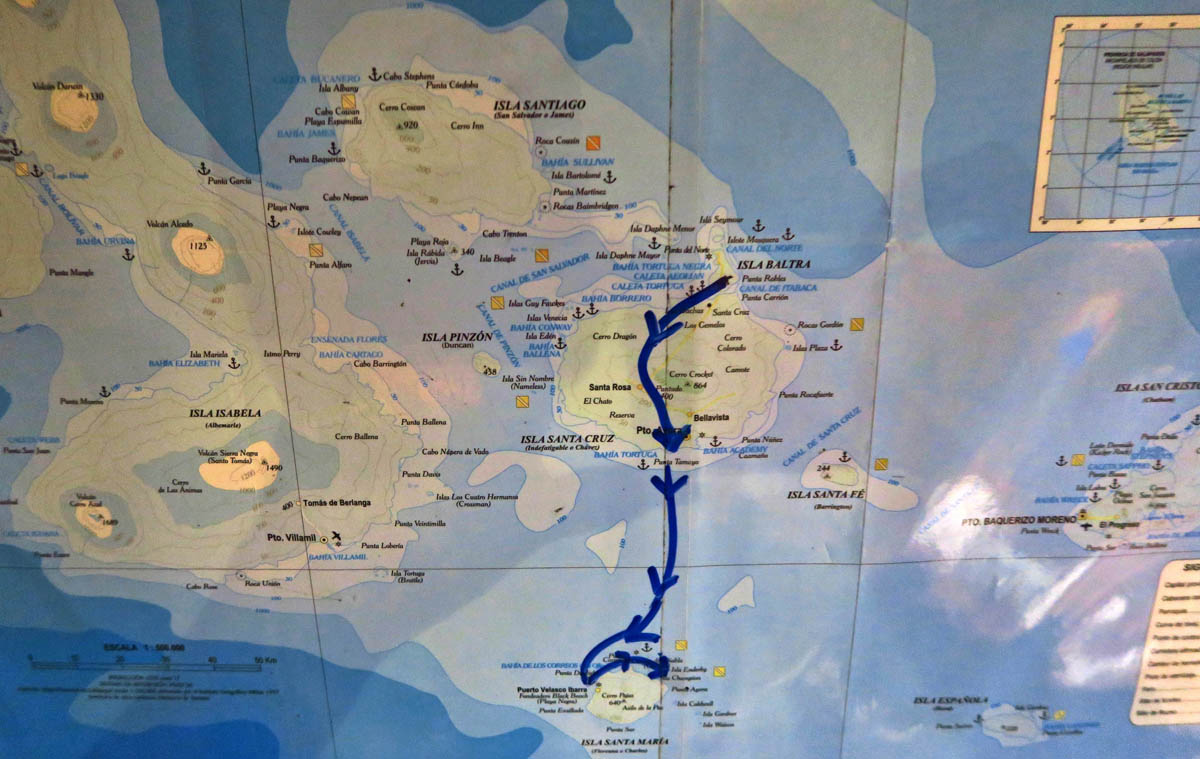
On the other side of the whiteboard is a map of the islands, where Fabian charts our progress at the end of each day.

Early mornings are the best time for a pensive moment, however, one has to get up pretty early to beat the coffee drinkers.
Our first excursion from the boat will be to visit the island of Floreana. Only about 100 people inhabit this island now, making it the smallest number of inhabitants, yet it is the longest inhabited island.
Floreana was also the sight of the first Galapagos Islands Post Office, established in 1793 by whalers, ergo the name “Post Office Bay.” Traveling mariners would leave letters in the post barrel in hopes that they would be collected by another traveler going in the direction of their home. This tradition continues to this day, as tourists leave postcards behind, and collect others addressed to their homeland, the custom being to deliver by hand.
We arrive for our first dry landing at Puerto Velasco Ibarra, home of two thirds of Floreana’s population. The concrete pathway from the dingy dock is crowded with local residents, dozens of sea lions and marine iguanas lounging around, causing us to have to step over them to reach the path. The national park rule is that one must remain two meters, or six feet from all wildlife at all times. However, sometimes this is just not possible, as in this case, they are all over the stairs and walkway.
Galapagos wildlife is notorious for being impervious to people. They have learned that tourists pose no threat, so they really don’t seem to care whether you are there are not. When it comes to human intervention, they simply have no fear.
For such a small population, I am surprised to see accommodations and a couple of small restaurants here. Floreana is one of only four islands where tourists who choose to visit by land tour (as opposed to cruise) can overnight.
We board a “taxi,” an open sided pick-up truck with bench seats for a 15 minute drive to the top of the island in the lush green highlands to visit a land tortoise “corral.” It’s a large fenced area at the base of Asilo de la Paz, a volcanic cone. While the Floreana tortoise is now extinct, the corral contains the various giant tortoises of other species that were originally owned by residents of Floreana. While not exactly “in the wild,” this large corral does allow the tortoises to roam freely throughout the large fenced area.
Land tortoises are classified into two main shell types, dome and saddleback. Tortoises with a dome-shaped shell lack the ability to extend their necks upward, therefore are found in places where lush vegetation grows lower to the ground. The saddle-back tortoise has an upward curve in the front of their shell, enabling them to extend their long necks up to reach higher vegetation, therefore are found in more arid areas. Darwin’s observations of these two shell types located according to food source was one of the key contributors to his theory of evolution.
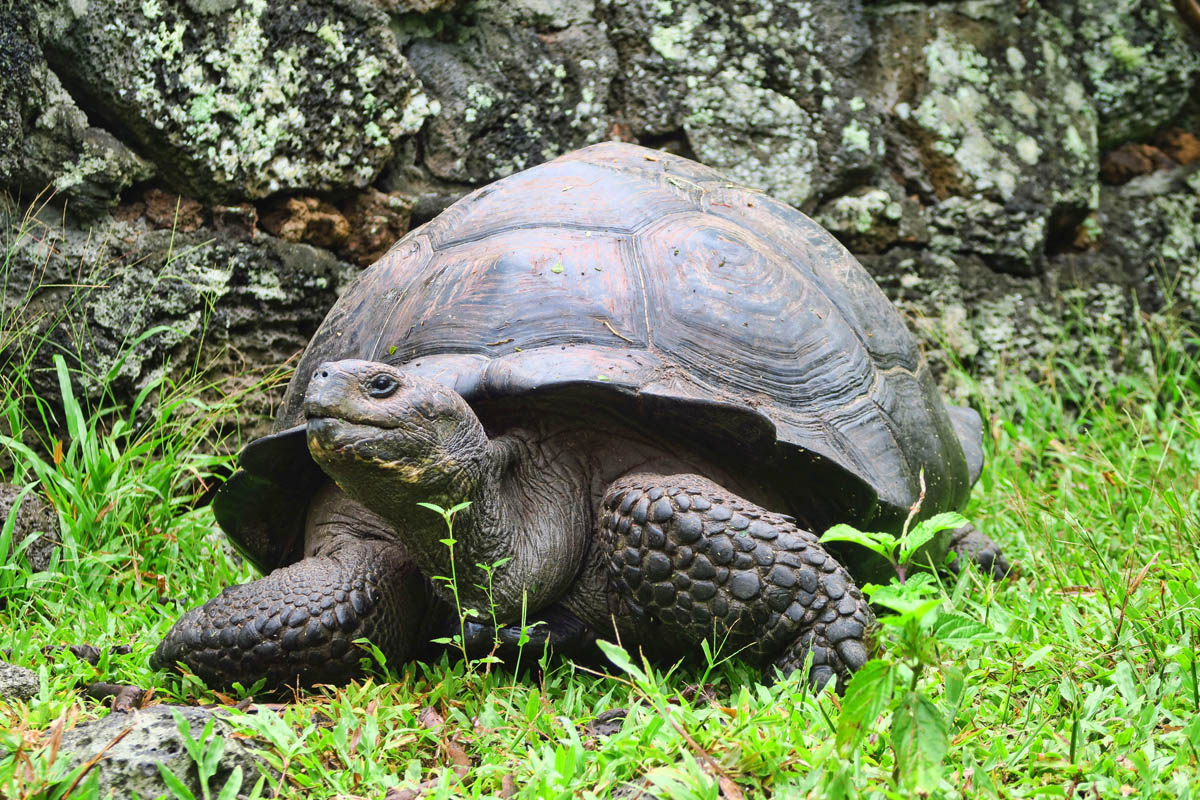
While there is a fence around the corral, they are in a much more natural setting than at the Darwin Research Station.

I stopped counting how many tortoises we saw in the corral area, adult and juvenile, when I got to twenty.
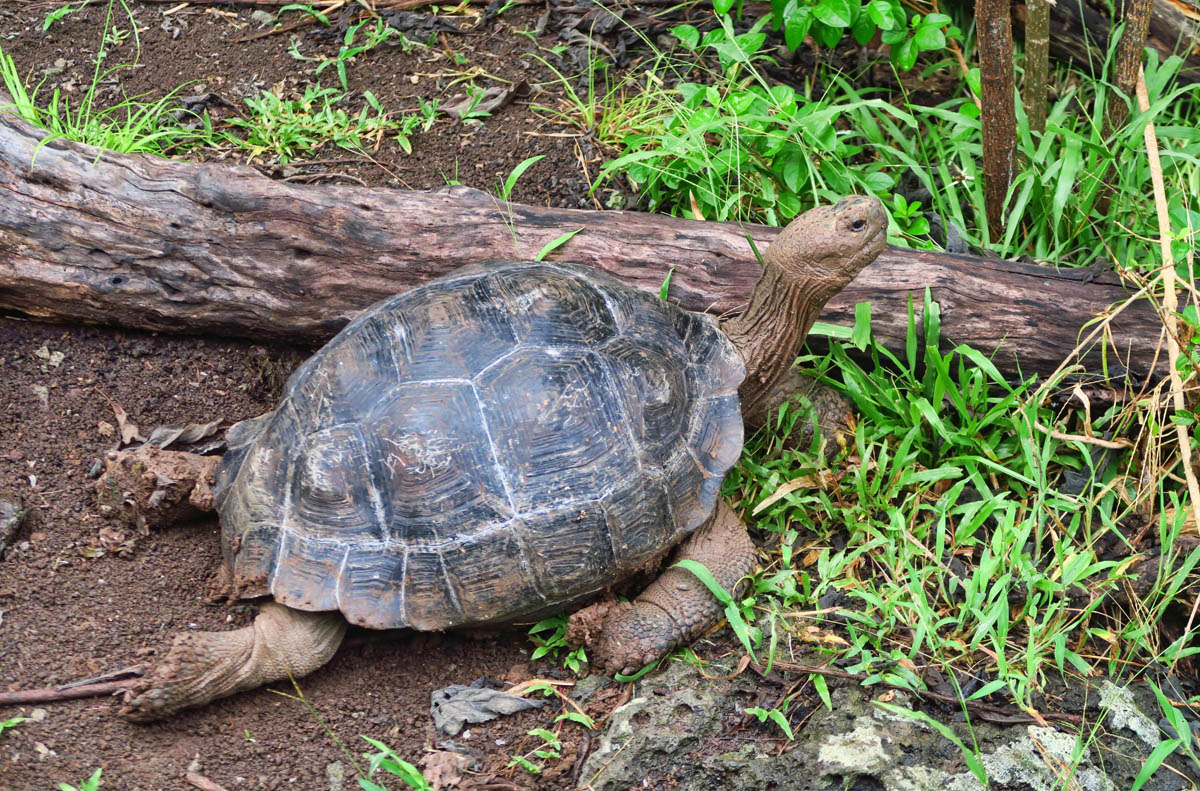
While there is plenty of vegetation for grazing, the tortoises are fed three times per week. They weigh up to 500 pounds and live to be over 100 years old.

Fabian, our Naturalist Guide, showing us a carved head statue to his right. No definite reason known for the purpose of the carving.

There are lots of “pirate caves” that were believed to be used for storing food, liquor, and pirate hideouts.
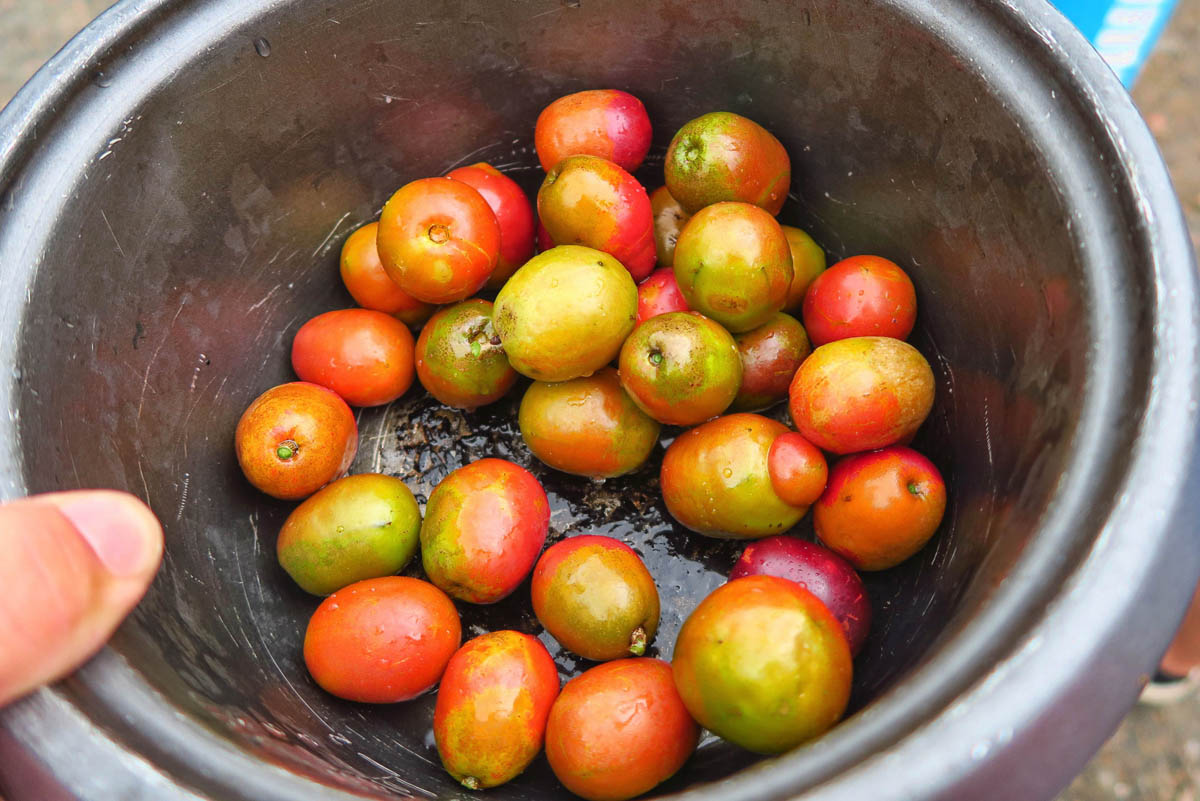
Fabian asks a neighbor if we can pick some of their “Ovo” fruit so everyone can have a taste. It is a little like a cross between a plum and a peach, but smaller.

Sally Lightfoot crabs are scavengers found on most beaches. They eat everything from sea lion placenta (eew!) to ticks off of marine iguanas.
While at the top of the island, we visit some pirate caves, as Fabian tells us stories of some of the more notorious inhabitants of the islands. I am particularly intrigued by Friedrich Ritter, a German doctor of holistic medicine, who, along with his female companion, chose to have all their teeth pulled prior to arriving on the island to avoid dental problems. Both used a steel plate inserted when necessary for chewing hard foods such as raw carrots grown on their farm.
Our next activity for the day would be a “deep water snorkel” near Devil’s Crown, remnants of an underwater volcanic crater. A 3mm “shortie” is a good choice for snorkeling at this time of year in the islands. In fact, I only end up wearing it on the deep water snorkels, as the water is warm enough for just a swimsuit in shallower water. The Galapagos Islands literally straddle the equator, yet water temperatures still fluctuate depending on ocean currents. December through March are the months when water temperature is the warmest.
While the snorkeling is enjoyable, surprisingly, it’s not my favorite activity in the islands. As I have mentioned before, I am a bit of a “snorkel snob,” having spent a lot of time hovering over some of the more famous tropical reefs. One doesn’t snorkel in the Galapagos for the reefs, but more for the marine life. But having seen more than my share of surgeon fish, parrot fish, black and white tipped sharks, I just frankly find the scenery above the surface to be more interesting than that beneath the surface. I will say, however, I haven’t seen that many schools of fish in a long while.
Our third activity for the day is a wet landing on Floreana, this time on the green olivine beach of Punta Cormorant, where we take a short hike to the brackish lagoon, one of only two places for viewing flamingos. And oh, did we ever get lucky to walk up to the pond just as a group was taking flight, showing off their black-tipped wings! So majestic!

It’s nearing dusk, so Fabian tells us there could be mosquitoes. He lines up his passengers and sprays all takers with insecticide.
Just over the hill from the lagoon is Flour Beach, a place well deserving of its name. An absolutely magical spot, it would end up being one of my favorite memories of the islands. The long, floury-sand beach is a primary location for the Galapagos green sea turtle to nest, the only sea turtle species to breed and nest in the Galapagos. As we stand in the shallows, activity just beyond the shoreline seems surreal as we watch dark spots in the waves take shape to reveal several sea turtles waiting for nightfall so they can come ashore to lay their eggs. We watch as rays mate in the translucent cresting waves. The twilight of the late evening and brooding dark clouds add to the mystique.
My new BFF and fellow crew-mate Kathy and I are the last to leave, as I fantasize about what it would be like to camp here on this desolate, perfectly pristine beach. As we head up over the hill, I turn to take one last look in hopes of burning this beautiful beach into my brain.
Back on board, the table is set with white table linens, as formal as it gets on the Beagle. Being our first full day on board, we will celebrate with a welcome cocktail, and introduction to our Captain and Crew. Dinner is jokingly billed as “Pelican a l’orange,” (tastes like chicken.)
With Floreana being one of our more open passages, it’s another rolly night. I find it hard to sleep, as my body is constantly tensing up, for fear I relax and thereby risk rolling out of bed. Finally, I get smart and line my exposed side with the pillows from the upper bunk. At 2:30am, the rolling blissfully stops as we drop anchor, and the engines go quiet, indicating we have reached our next day’s destination, Española Island.
“The love for all living creatures is the most noble attribute of man” ` Charles Darwin


















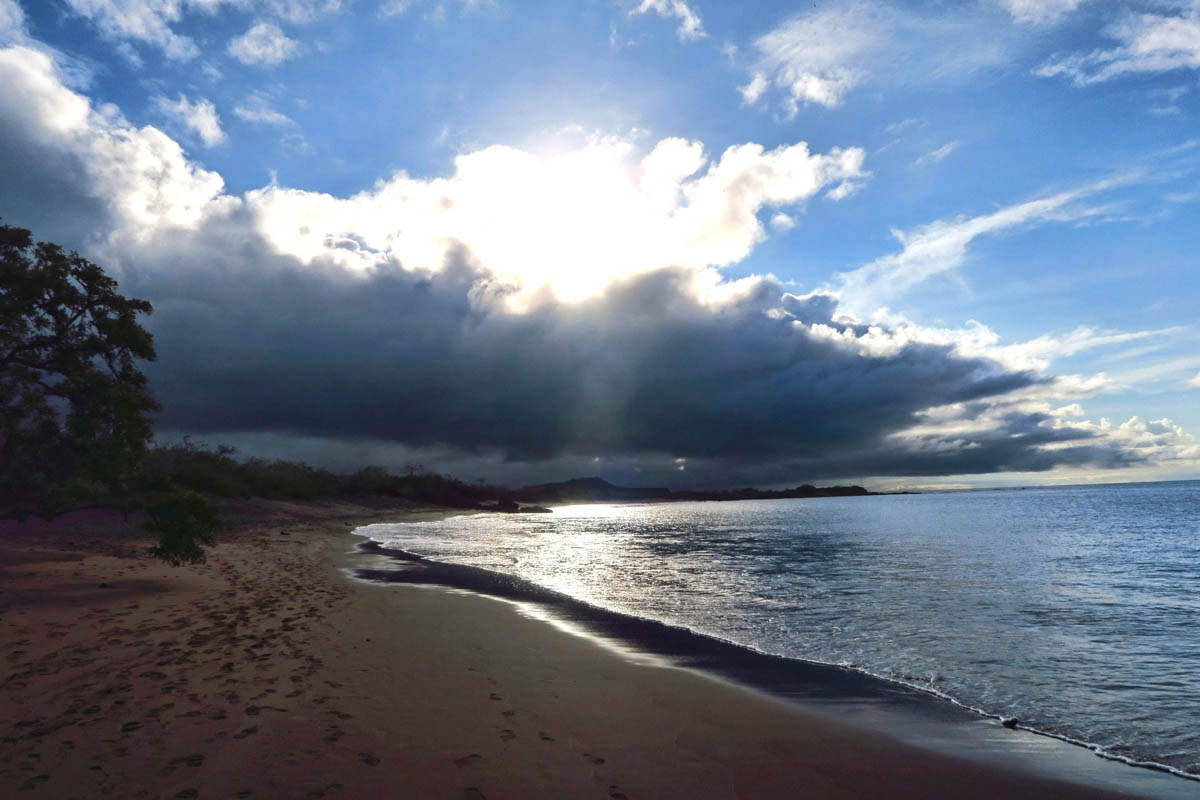






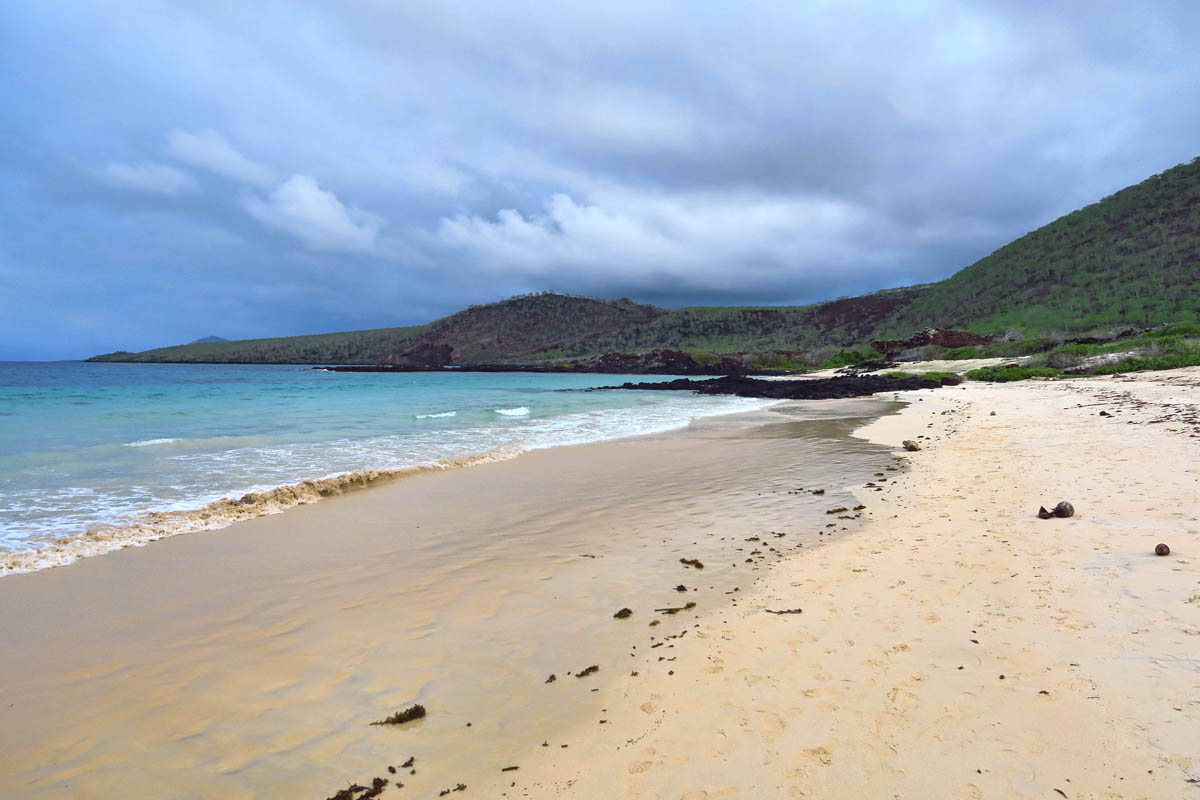

I’ve slept near diesel engines on sailboats that must motor at night 🙂 but good thing it’s a fabulous day coming up eh? You are SO LUCKY to have this experience! and your photos/tales are wonderful, thank you so much for sharing!
Oh just to see the turtles come in to lay their eggs, how very special.
But wait! Those aren’t black, brown or red birds!! What an incredible experience. One question…what does the smiling man in the red shorts (waiting for mosquito spray) have hanging around his neck??
Right, Kat?? PINK BIRDS!! Reason enough to go to the Galapagos!
That smiling man is Walter from the Netherlands. Walter was at one time, among other things, a member of the Board of Directors of the dairy conglomeration, therefore earned the nickname of the “Milkman.” I believe Walter is using his money belt carried around his neck as a camera case. 😉
Reason enough if you care about things like PINK birds.
I am enjoying your Galapagos posts so far and look forward to the next six!
It’s hard to believe that Friedrich Ritter’s female companion went along with having all her teeth pulled and using a steel plate to chew. They must have been a very devoted couple 🙂
I’m so enjoying your postings on the Galapagos! That big iguana is kind of “evil” looking!
It’s Springtime in Maryland and gorgeous and here you go making wish I was somewhere else… sailing. What a wonderful adventure you are having, I (we) can’t wait to share tales with you across a bar table or maybe better yet a picnic table. Stay safe and have even more fun!
Count me as another devotee of your photos and experiences. This is as close as I’ll ever get to the Galapagos, but you are bringing us along. Flour Beach must have been magical. Thank you so very much!
Incredible. Those Iguanas look fat and sassy! That is truly and adventure of a lifetime, good to see you are making the most of it.
We are really enjoying this stop on your trip, read it yesterday and again today. Love that fat lizard.
Glad to see you finally took some bird photos for me & your mom, no doubt. 😉
I love the name of the pretty little crabs!
And are those your “unmentionables” waiving in the wind in your last photo?! 🙂 (just kiddin’)!
Eggggzactly! I stood there guilting myself, thinking, “well, okay…Mom and Karen will be reading, so I guess I should take one or two.” 😉 xoxox